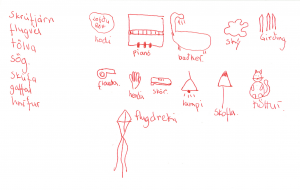NEW RESEARCH SHOWS THAT PEOPLE WHO HAVE DIFFICULTY REMEMBERING WORDS ARE ABOUT 45 TIMES MORE LIKELY TO MEMORIZE A WORD IN THE LONG TERM BY DRAWING ITS MEANING
Ground-breaking findings highlighted in the article reveal that drawing significantly improves memory, especially for individuals who struggle with remembering words. The study shows these individuals were generally about 45 times more likely to remember words in the long term when drawing their content as opposed to writing them.
Dr. Ãttarsdóttirâs research consisted of asking 134 children and 262 adults to draw and write the meaning of words, and then to recall those words after varying time periods. The new results provided by the study demonstrate that children and adults who struggle to remember written words are the ones who benefit most from drawing for memorization. The difference is so pronounced that children in that group were generally able to recall their drawings about 45 times more easily than the words they had written a few weeks earlier.
Moreover, the study also shows that people who easily remember words generally remember a greater number of written words than drawings when memorizing in the short term. However, when remembering in the longer term, those individuals who easily remembered words also recalled their drawings more easily than the written words.
âDrawing is not meant to replace more conventional educational methods, like reading and writing; rather, drawing can open up the possibilities of learning through those more traditional means,â said Ãttarsdóttir.
Unnur Ãttarsdóttirâs memory drawing study marks a turning point in the history of art therapy, education, and psychology in a global context.
âTo the best of my knowledge, this is the first time this kind of research on memory of drawing and words for people who have different capacities for memorizing words has been conducted worldwide, and the findings are intriguing," said Dr. Ãttarsdóttir.
Ãttarsdóttir, a prominent scientist focusing on memory drawing, started her practice and research in art therapy in the early 1990s. She has written about the topic, given talks, and taught at conferences and universities around the world. According to Ãttarsdóttir, drawing has an emotional value, in addition to being a more effective memory enhancer than writing.
Apart from this latest research, Ãttarsdóttir has also conducted a related study with children who have specific learning difficulties and have experienced stress or trauma. In addition to helping the children learn and memorize, Ãttarsdóttir found indications that the act of drawing could also facilitate the processing of emotions sometimes associated with difficult experiences.
âAn important part of the learning process through drawing is to understand the drawersâ emotional lives and have knowledge of the emotional processes included in drawing. Drawing is both for learning, including memorizing, and also for emotional processing. Art therapy theories are important for understanding the memory drawing process,â she pointed out.
Ãttarsdóttir is available for interviews about the memory drawing study and its findings. To schedule an interview, contact her through email at unnur@unnurarttherapy.is or by phone at +354 8670277.
The full paper on the research, âExperiments on the Efficacy of Drawing for Memorization among Adults and Children with Varying Written Word Memory Capacities: A Two-Way Crossover Design,â was published in Education Sciences and can be viewed at https://www.mdpi.com/2227-7102/14/5/470.
####
Dr. Unnur Guðrún Ãttarsdóttir is an educator, special education teacher, art therapist, artist and researcher at the Reykjavik Academy in Iceland. She received a PhD degree in art therapy from the University of Hertfordshire in 2006. Ãttarsdóttir taught children and adolescents of all ages in Icelandic schools from 1982 to 1994. She has practiced art therapy and art educational therapy in private practice and in a variety of organizations, including schools, since 1991. Unnur has taught art therapy at the Iceland University of the Arts, the Continuing Education Department of the University of Akureyri, the Continuing Education Department of the University of Iceland, the British Association of Art Therapists, the Art Therapy Association of Romania, the University of Hertfordshire, Art Therapy Italiana, and the HAN University of Applied Sciences. Unnur sat in a steering group (2018-2021) for an international Erasmus project called âSocial Inclusion and Well-being through the Arts and Interdisciplinary Practices" that was led by the Iceland University of the Arts. Ãttarsdóttir presently sits in a steering group for the Research Committee of the European Federation of Art Therapy and is on the board of the Reykjavik Academy. Ãttarsdóttir is one of the leading scientists on the subject of memory drawing. Her research interests include art therapy in education for children with specific learning difficulties who have experienced trauma, along with art-making as a therapeutic and learning approach, which includes drawing for memorization and emotional processing. Ãttarsdóttir has lectured and written articles and book chapters that have been published worldwide about art therapy, art educational therapy, memory drawing, research through art, and the methodology of grounded theory.
Unnur Ãttarsdóttir
Art Therapy Ottarsdottir
+354 867 0277
unnur@unnurarttherapy.is
Visit us on social media:
Facebook
X
LinkedIn
Instagram
YouTube
Other
Drawing is a powerful memorization tool, particularly for those with difficulty remembering words




